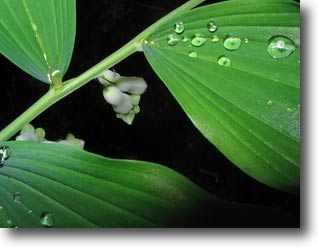The Natives are Restless
My Native
Plant Collection
Gardening is civil and social, but it wants the vigor and freedom of the forest and the outlaw. - Henry David Thoreau 1817-1862
 Every discussion of native plant collections should include the following guidelines - NEVER EVER collect plants in the wild without 1.) a permit to collect -or- 2) permission from the land owner. Never collect rare or endangered species unless you have the credentials and/or authority to officially preserve the plants. Never purchase plants from vendors that cannot produce proof of cultivation or adequate documentation of appropriate collection of plant material. 'Plant poaching' is an environmental crime and a punishable offense in most areas. If you find a particularly fine stand of a particular plant, rest assured you are not the first. Others will notice if it suddenly disappears. There are groups that report these thefts and coordinate their efforts to watch for the plants to reach market. Many poachers have been brought to justice this way. Harvesting native plants can have other unanticipated issues as well.
Every discussion of native plant collections should include the following guidelines - NEVER EVER collect plants in the wild without 1.) a permit to collect -or- 2) permission from the land owner. Never collect rare or endangered species unless you have the credentials and/or authority to officially preserve the plants. Never purchase plants from vendors that cannot produce proof of cultivation or adequate documentation of appropriate collection of plant material. 'Plant poaching' is an environmental crime and a punishable offense in most areas. If you find a particularly fine stand of a particular plant, rest assured you are not the first. Others will notice if it suddenly disappears. There are groups that report these thefts and coordinate their efforts to watch for the plants to reach market. Many poachers have been brought to justice this way. Harvesting native plants can have other unanticipated issues as well. Sometimes growing native plants side by side with hybrid species can be a challenge. While the hybrids are begging for water and fertilizer on a regular basis, the natives are sometimes highly offended by similar treatment. Typically, native plants are considered to be more disease resistant, and require no artificial watering once established. Many times this simply translates to a plant that is more difficult to sustain than a hybrid, although the reality is a balance between these two perspectives.
All plants want to grow, bloom, pollinate and reproduce. It's just a matter of discovering the right combination of conditions that can turn a difficult species into a weed! Sometimes an ornamental is someone else's weed grown just far enough out of its comfort zone that it doesn't run amok in your garden. Certain pond plants meet this criteria - the water hyacinth is illegal to ship into certain parts of the country because of eradication efforts currently in play. I have a difficult time getting them to grow in my pond and I pay a premium price for them every time I want to try.
I have collected a number of native species for my yard. Some thrive, some survive. Some do require special conditions. Others seem to thrive all on their own. Some, the native plant experts suggest you don't even bother trying. Sometimes you just get lucky, I guess. Here's what I've got going on in this arena -
Adiantum capillus-veneris - Maidenhair Fern
Adiantum pedantum - Five Finger Fern
Aruncus sylvester - Goatsbeard
Asarum caudatum - Western Wild Ginger
Aquilegia formosa - Western Columbine
Blechnum spicant - Deer Fern
Caltha asarifolium - Marshmarigold
Camassia quamash - Camas
Cornus canadensis - Bunch berry
Dicentra formosa - Western Bleeding Heart
Dodecatheon hendersonii - Pink Shooting Star
Erythronium oregonum - White Fawn Lily
Goodyera oblongifolia - Rattlesnake Plantain (native orchid)
Iris tenax- Oregon Iris
Lilium columbianum - Tiger or Turk's Cap Lily
Linnaea borealis - Twinflower
Mimulus
cardinalis - Red Monkey Flower
Mimulus guttatus - Yellow Monkey Flower
Oxalis oregana - Oregon Wood-sorrel
Ploygonatum biflorum - Solomon's Seal (Eastern N. Am native - an exotic species here!)
Polystichum munitum - Sword Fern
Ribes lobbii - Fuchsia flowered gooseberry
Ribes sanguineum - Blood Currant
Sisyrinchium angustifolium - Blue Eyed Grass
Sisyrinchium californicum - Yellow Eyed Grass
Tellima grandiflora - Fringe Cup
Thalictrum occidentale - Medow Rue
Trientalis latifolium - Western Starflower
Trillium ovatum - Western Trillium
Viola orbiculata - Yellow Violet
For the most part these plants are scattered about the yard, mixing and mingling with more 'exotic' species. A few wetland species live in an artificial bog and some live in and around the pond. Otherwise, you'll find little 'surprises' tucked away in the most unexpected places.